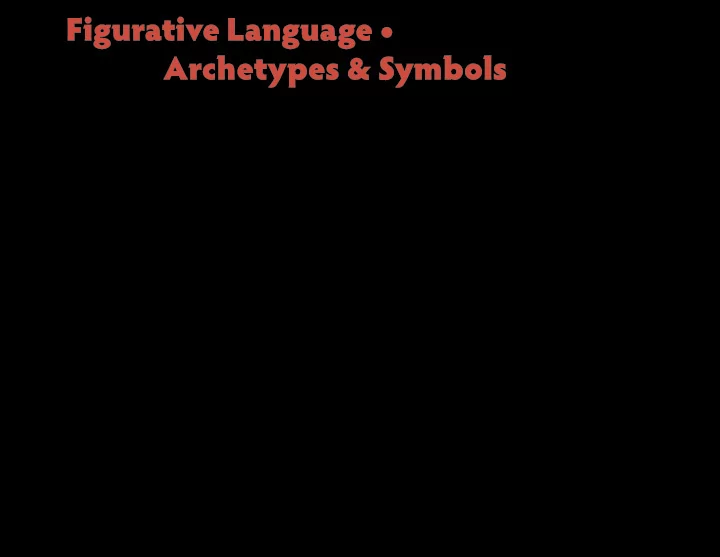

Figurative Language • Archetypes & Symbols revised 01.25.13 || English 1302: Composition II || D. Glen Smith, instructor
Figurative Language symbol: a visual representation of something else motif: a reoccurring symbol in various forms which appears throughout a selected work revised 01.25.13 || English 1302: Composition II || D. Glen Smith, instructor 2
Figurative Language metaphor: language that implies a relationship between two unlikely elements: All the world’s a stage, And all the men and women merely players; They have their exits and their entrances, And one man in his time plays many parts, His acts being seven ages ( Shakespeare). simile: makes comparisons of two elements, but ties them together with additional words: like or as The torn edges of the ancient book shone yellow as an autumn moon. revised 01.25.13 || English 1302: Composition II || D. Glen Smith, instructor 3
Figurative Language personifjcation: a fjgure of speech giving an inanimate object or abstract idea human characteristics for literary purposes Death sat in the corner thoughtfully smoking his pipe, staring at the young men and women in the pub. anthropomorphism: interpretation of animals with humanistic personalities Mickey Mouse SpongeBob SquarePants revised 01.25.13 || English 1302: Composition II || D. Glen Smith, instructor 4
Archetypes (see LWP : p. 135) In simplest terms, these are patterns, characteristics of personality traits which appear in fjction. Northrop Frye, a Canadian literary critic, took the original Jungian concept of psychoanalysis and applied it to writing and criticism. He believed every concept which is re-invented in literature has a mythical origin which humans, as an analytical species, carry with us in our heads. examples: • the hero’s quest • a runaway, rebellious daughter • the good mother • the evil stepmother • a wise old man • a fool-comedian • the innocent virgin • the nerdy, isolated intellectual { however, do not confuse with stereotypes revised 01.25.13 || English 1302: Composition II || D. Glen Smith, instructor 5
Archetypes Archetypes belong to the family of elements of: • epitome: are representatives or perfect example of a type of person • stereotype: are oversimplifjed and exaggerated characteristics which then are applied to groups of people > race > nationality > religion > creed revised 01.25.13 || English 1302: Composition II || D. Glen Smith, instructor 6
Archetypes A basic image can translate to archetype, just by how an author chooses to illustrate the image. A simple apple has multiple applications. revised 01.25.13 || English 1302: Composition II || D. Glen Smith, instructor 7
Symbols ( LWP : p. 134-135, 136) A symbol is an image which acts as a representation of something else. • The Venus of Willendorf and the cave drawings in Lascaux, France are early humanity’s attempt at rationalizing a world. Numerous discussions are centered on the function or artistic value early people placed on these images. • The act of creating of symbols is basically what separates humans from other animal species. revised 01.25.13 || English 1302: Composition II || D. Glen Smith, instructor 8
Symbols • To take this to another level, an American literary theorist, Kenneth Burke, in a 1964 issue of The Hudson Review, defjnes humanity as: “the symbol using, making, and mis-using animal” (“Defjnition of Man”). In part, the article aims to clarify what metaphoric interpretations are developed in our species. Keep in Mind: • By analyzing plausible symbols in a story helps examine literature as a whole and brings closer understanding of how the canon works. • In fjction, any image within a story can be argued as an intentional or subconscious symbol on the part of the author. • T he theories proposed in class have been developed over a number of years and are based on numerous resources, including material left behind by the original authors. revised 01.25.13 || English 1302: Composition II || D. Glen Smith, instructor 9
Symbols Finding what a specifjc symbol represents to an individual writer can be argued many ways. Your personal interpretation can be valid if backed with evidence from the story or poem itself. Likewise, some authors intentionally use an image which can carry multiple meanings. Even the images utilized within a “basic” children’s story like L. Frank Baum’s novel, The Wonderful Wizard of Oz, can carry numerous interpretations. The yellow brick road by itself is a plot device to move Dorothy on a journey across the plot. The exact meaning of the road is open for discussion. • search for meaning in life • good acts gain positive rewards • perseverance in life leads to success revised 01.25.13 || English 1302: Composition II || D. Glen Smith, instructor 10
Symbols basic image > symbol > archetype revised 01.25.13 || English 1302: Composition II || D. Glen Smith, instructor 11
Allegory • traditionally operates as a narrative which utilizes basic symbols • the symbols are representations of abstract concepts, which in turn, are displayed as concrete images > they cannot move beyond their defjned role > individually these symbols can only represent one idea, one element For example: If a personifjed allegory of Literature walked into this room, she would be limited in her discussions and interactions with the class. She could only discuss literary works as a whole, not sport scores, economic conditions, weather, or any other subject. Her participation would be restricted to her basic defjnition. revised 01.25.13 || English 1302: Composition II || D. Glen Smith, instructor 12
Recommend
More recommend